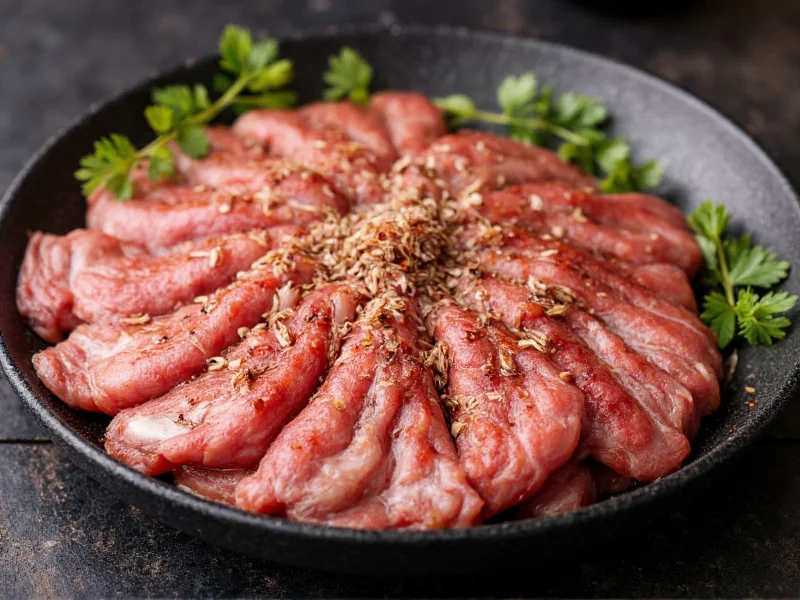Understanding how to properly season pork fillet—also known as pork tenderloin—is essential for creating restaurant-quality dishes at home. This lean, tender cut of pork benefits from thoughtful seasoning that enhances its delicate flavor without overpowering it. Unlike fattier cuts, pork fillet has minimal marbling, making proper seasoning technique crucial for a flavorful result.
Why Proper Pork Fillet Seasoning Matters
Pork fillet's mild flavor profile makes it incredibly versatile, but also means it requires strategic seasoning. Without adequate flavor enhancement, this premium cut can taste bland. The right seasoning blend creates a flavorful crust during cooking while keeping the interior juicy and tender. Proper seasoning timing also allows flavors to penetrate beyond just the surface layer.
Essential Components of Pork Fillet Seasoning
A well-balanced pork fillet seasoning contains four key elements that work together to create depth of flavor:
Salt as the Foundation
Salt is non-negotiable in any pork fillet seasoning blend. It enhances natural flavors and helps retain moisture during cooking. For best results, use kosher salt which adheres well and provides even seasoning. The ideal ratio is approximately ¾ teaspoon of kosher salt per pound of pork.
Aromatic Herbs
Fresh or dried herbs provide the characteristic flavor profile for pork:
- Rosemary: Earthy and pine-like, perfect for roasted pork fillet
- Thyme: Subtle lemon notes that complement pork's natural sweetness
- Sage: Traditional pairing that enhances pork's savory qualities
Garlic and Onion Elements
Garlic powder (not garlic salt) provides consistent flavor without burning. Onion powder adds sweetness and depth. These aromatics form the backbone of most successful pork tenderloin seasoning blends.
Spice Components
Additional spices can create distinctive flavor profiles:
- Smoked paprika: Adds depth and subtle smokiness
- Black pepper: Freshly ground provides essential heat and complexity
- Brown sugar: Small amounts help with caramelization (1-2 teaspoons per pound)
Recommended Pork Fillet Seasoning Blends
Here are four proven seasoning combinations for different cooking methods and flavor preferences:
| Seasoning Blend | Ingredients (per pound of pork) | Best Cooking Method | Flavor Profile |
|---|---|---|---|
| Classic Roast Blend | 1½ tsp kosher salt, 1 tsp black pepper, 1 tsp garlic powder, 1 tsp dried rosemary, ½ tsp dried thyme | Oven roasting | Traditional herb-forward flavor |
| Smoky Grill Rub | 1½ tsp kosher salt, 1 tsp smoked paprika, 1 tsp garlic powder, ½ tsp onion powder, ½ tsp cumin, ¼ tsp cayenne | Grilling | Rich, smoky with subtle heat |
| Simple Pan-Seared | 1½ tsp kosher salt, 1 tsp black pepper, 1 tsp garlic powder | Pan-searing | Clean, straightforward pork flavor |
| Sweet & Savory | 1½ tsp kosher salt, 1 tsp garlic powder, 1 tsp dried thyme, 1 tbsp brown sugar, ½ tsp mustard powder | Oven or grill | Balanced sweet-savory crust |
Proper Seasoning Technique for Pork Fillet
How you apply seasoning matters as much as the blend itself. Follow these professional techniques for best results:
Timing Is Critical
Season pork fillet at least 30 minutes before cooking, preferably 1-2 hours. This allows salt to penetrate beyond the surface through osmosis, seasoning the meat internally rather than just on the surface. For even better results, season 24 hours in advance and refrigerate uncovered—this creates a superior crust during cooking.
Dry Rub Application Method
When using a dry rub for pork tenderloin seasoning:
- Dry the pork fillet thoroughly with paper towels
- Evenly distribute seasoning over all surfaces
- Gently press the rub into the meat
- Allow to rest at room temperature for 30-60 minutes before cooking
Marinade Considerations
For wet marinades, limit acidic components (like vinegar or citrus) to no more than 2 hours to prevent the meat from becoming mushy. A simple marinade of olive oil, Dijon mustard, minced garlic, and fresh herbs works beautifully for pork fillet without compromising texture.
Avoiding Common Pork Fillet Seasoning Mistakes
Even experienced cooks make these seasoning errors with pork fillet:
Over-Seasoning with Salt
While pork fillet needs adequate salt, too much creates an unpleasantly salty dish. Remember that ¾-1 teaspoon of kosher salt per pound is sufficient—table salt requires less due to smaller crystal size.
Using Pre-Mixed Seasonings
Many commercial pork seasoning blends contain fillers and excessive salt. Creating your own blend ensures control over ingredients and proportions, resulting in better flavor balance for pork tenderloin seasoning.
Seasoning Immediately Before Cooking
Applying seasoning at the last minute only flavors the surface. Proper seasoning requires time for the flavors to penetrate, enhancing the entire cut rather than just creating a seasoned crust.
Cooking Considerations with Seasoned Pork Fillet
Seasoned pork fillet requires specific cooking approaches:
- Temperature control: Cook to 140-145°F internal temperature for optimal tenderness
- Resting time: Allow 5-10 minutes resting after cooking before slicing
- Heat management: Start with high heat to sear, then reduce for even cooking
The seasoning creates a flavorful crust that locks in juices, but overcooking will still dry out this lean cut regardless of seasoning quality. Use a meat thermometer for best results with your seasoned pork fillet.
Complementary Side Dishes for Seasoned Pork Fillet
Consider these pairings that enhance rather than compete with your pork fillet seasoning:
- Roasted root vegetables (carrots, parsnips, potatoes)
- Apple sauce or apple butter for classic pork pairing
- Simple green salad with vinaigrette
- Creamy polenta or mashed potatoes











 浙公网安备
33010002000092号
浙公网安备
33010002000092号 浙B2-20120091-4
浙B2-20120091-4